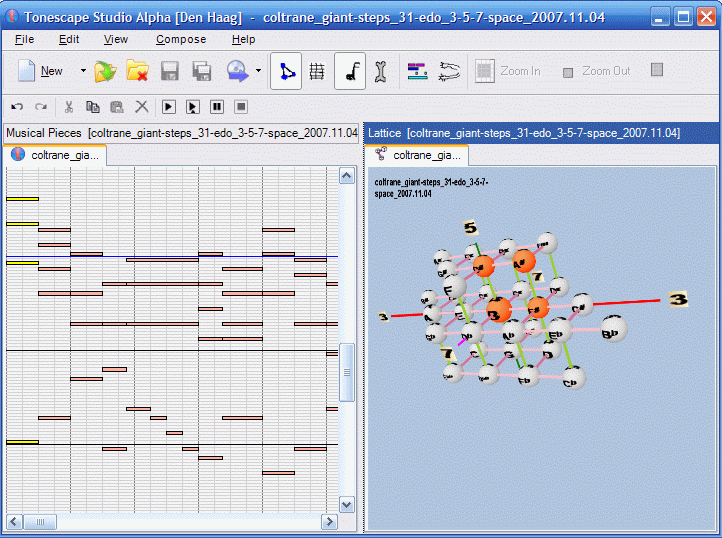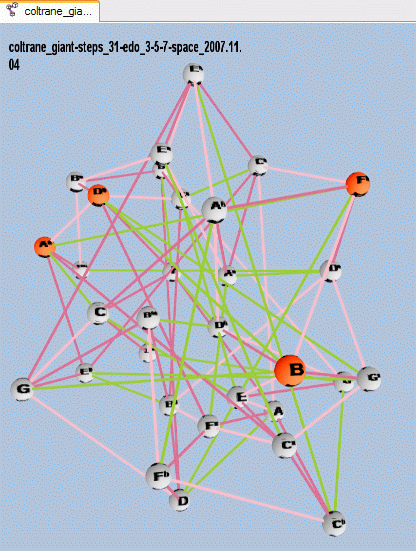John Coltrane: Giant Steps
analysis of chord progressions
in various tunings
John Coltrane's landmark tune Giant Steps (1960) utilizes a harmonic plan which showcases 12-edo tuning's membership in both the aristoxenean and the augmented temperament families: the former by repetition of the dominant-7th-to-tonic functions, and the latter by the arrangement of tonics as a cycle of major-3rds. The chord progressions are as follows:
LEGEND:
- In the chord symbols, "z" is used to represent the triangle which is commonly used for major; the other two symbols are the usual "x" for dominant and "m" for minor;
- it is assumed that all chords include the 7th, and they may also include the extension 9th and/or 13th;
- the analysis underneath the chord symbols shows how the V-I and II-V-I progressions circulate thru the three keys, which are indicated on the left in brackets.
Bz Dx | Gz Bbx | Ebz | Am Dx |
[G]: V | I | | II V |
[Eb]: | V | I | |
[B]: I | | | |
Gz Bbx | Ebz F#x | Bz | Fm Bbx |
[G]: I | | | |
[Eb]: V | I | | II V |
[B]: | V | I | |
Ebz | Am Dx | Gz | C#m F#x |
[G]: | II V | I | |
[Eb]: I | | | |
[B]: | | | II V |
Bz | Fm Bbx | Ebz | C#m F#x |
[G]: | | | |
[Eb]: | II V | I | |
[B]: I | | | II V |
Below is another version of the analysis, using more familiar abbreviations for the chord symbols: "M7" = major-7th, "m7" = minor-7th, "7" = dominant-7th:
BM7 D7 | GM7 Bb7 | EbM7 | Am7 D7 |
[G]: V | I | | II V |
[Eb]: | V | I | |
[B]: I | | | |
GM7 Bb7 | EbM7 F#7 | BM7 | Fm7 Bb7 |
[G]: I | | | |
[Eb]: V | I | | II V |
[B]: | V | I | |
EbM7 | Am7 D7 | GM7 | C#m7 F#7 |
[G]: | II V | I | |
[Eb]: I | | | |
[B]: | | | II V |
BM7 | Fm7 Bb7 | EbM7 | C#m7 F#7 |
[G]: | | | |
[Eb]: | II V | I | |
[B]: I | | | II V |
Giant Steps in 31-edo tuning
31-edo is the first non-12-edo tuning i tried for Giant Steps. I chose 31-edo because it offers low error for prime factors 5 and 7, which are featured prominently in jazz, and its error for 3 is good enough to preserve the approximation to pythagorean root-movement. The arrangement is my own, as i play it on the piano, and the instrument timbre used is acoustic guitar. The original was done in Tonescape®, and all the other formats were generated automatically from that by Tonescape; below are the downloadable links:
- Tonescape Musical Piece
- MIDI
- Csound unified file (.sco + .orc) -- see also the printout of the Csound output screen
- .wav file
Below is a screenshot of the opening chord being played in Tonescape, with the Lattice using Rectangular Geometry:

Below is the same chord, with the Lattice using Closed Curved crumpled-napkin Geometry:

The chords use the same spelling as in the analysis above, and therefore their progressions do not always follow identical pitch patterns in 31-edo as they do in 12-edo. I plan to make another 31-edo version which does preserve the same pitch patterns, but this will modulate into remote keys which in 12-edo are enharmonic equivalents but in 31-edo are not.
